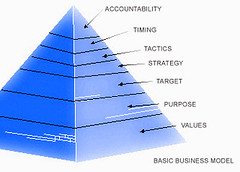Since I have two answers and needed additional space beyond the confines of a comment box, I thought I would reintroduce the question here.
Although I’ve worked with dozens of start-ups and venture capital companies, one of the better models I’ve seen was not presented by a client. It was presented by L. Robert Kimball & Associates, an architectural and engineering company, who lent it to the National Emergency Number Association (NENA) a few years ago. The graphic on this page provides the basic concept, but I’ve adapted some terms to better suit my needs.
Anyway, NENA gave me this strategic plan model because I was about to conduct what I call a “core message system” session for the association, and several board members were unclear where a “core message system” might fit within the scope of a strategic plan.
So where does it go? I explained that it fits comfortably in one of two places: a core message system can be implemented as part of a communication plan at the strategic level (strategy). Or, it can positioned to precede values, making it the "foundation for the foundation." But the decision, where it fits best, is largely based upon where the executive team wants to implement it.
The difference between either location, in terms of outcome, is the potential benefit to the organization. Some companies prefer to limit the “core message system” to their communication plan while others want it to infuse into other aspects of their company or organization, ranging from hiring practices to product and service innovation.
After considering this, the board members commented that it seemed more fitting to call the process a “core values session.” With so many business terms being bandied about today, I agreed. For you, I said, it’s core values.
In all honesty, I probably would call it “core values” all the time if not for the simple fact that most business executives balk at the idea that some guy wants to monkey around with their core values. (It’s hard enough to add “strategic” to their “communication.”)
But then again, I never put too much weight on semantics. Instead, I listen to each company’s language and adapt. From what I’ve seen in the field, the difference between a purpose, mission, and vision is all in the eyes of the audience, which brings me back to Maister’s question.
Technically, you can’t choose just one because they are all interconnected. However, if I was going to force an answer, I would lean toward core values.
The only problem in doing so is that we fall into a trap of which comes first: the chicken or the egg?
More to the point, does our culture influence our values or do our values influence our culture? But what about our mission? Mission? Isn’t that dated? Everybody is using “purpose” nowadays. Dated? You mean like stone-washed jeans? I thought we were talking about business? You know, where are going? Ah, vision?
What a mess! I think this is precisely why I fell in love with what I call the core message (but you can call it something else if you like).
I have a much better definition, but for this post, let's say: It’s a process that pulls together key stakeholders (usually defined by the CEO), who are already immersed in the existing corporate culture, to reach a consensus about the company as it exists and will exist in the world. From this understanding, it's easier to establish values. And from values, it's easier to define a purpose, mission, and vision (or direction, I suppose).
Of course, this assumes we’re applying the core message as the foundation for the foundation. As I said earlier, you don’t have to. A communication department can limit a core message to communication with equal success.
So my second answer is a core message system, because it considers everything, including the environment in which the company operates and it's competitors. Of course, since few people have heard of it, I didn’t want to make it my first answer. Besides, it wasn't even on the list.
In closing, just to add clarity to the quick graphic I pulled together, think of it in its simplest terms, working up the pyramid: core values (foundation); purpose (why); target (where); strategy (what); tactics (how); timing (when); and accountability (who). Or, since this is about strategy as opposed to semantics, plug in your terms and see if it fits.



















1 comments:
Famous Last Words:
"Most marketers, probably you, are busy putting your round pegs in the round holes that have been given to you. What if you did the opposite?" — Seth Godin, in a seeminly unrelated post that relates.
That's what we like to do the most: change the holes.
Post a Comment